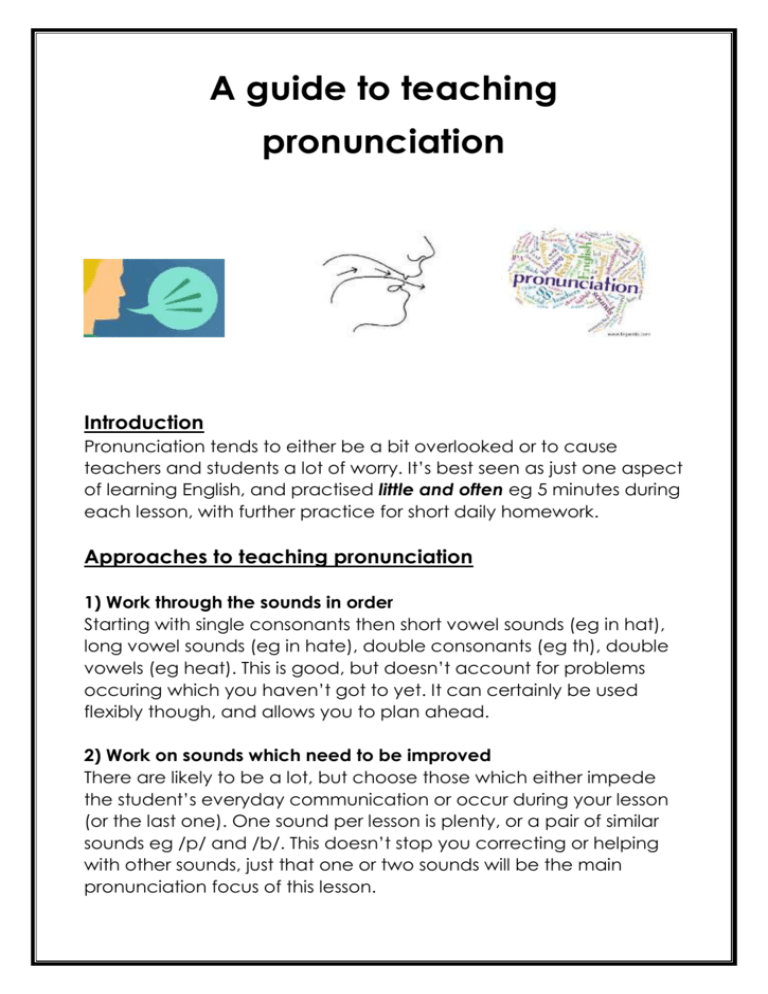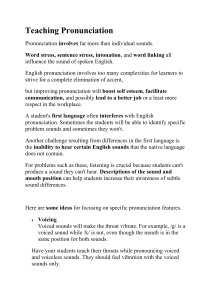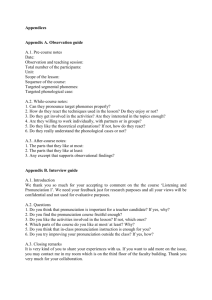A guide to teaching pronunciation
advertisement

A guide to teaching pronunciation Introduction Pronunciation tends to either be a bit overlooked or to cause teachers and students a lot of worry. It’s best seen as just one aspect of learning English, and practised little and often eg 5 minutes during each lesson, with further practice for short daily homework. Approaches to teaching pronunciation 1) Work through the sounds in order Starting with single consonants then short vowel sounds (eg in hat), long vowel sounds (eg in hate), double consonants (eg th), double vowels (eg heat). This is good, but doesn’t account for problems occuring which you haven’t got to yet. It can certainly be used flexibly though, and allows you to plan ahead. 2) Work on sounds which need to be improved There are likely to be a lot, but choose those which either impede the student’s everyday communication or occur during your lesson (or the last one). One sound per lesson is plenty, or a pair of similar sounds eg /p/ and /b/. This doesn’t stop you correcting or helping with other sounds, just that one or two sounds will be the main pronunciation focus of this lesson. Teaching techniques Just saying the sounds over and over might work if your student has very good aural skills, but most students need more than this. 1) Say the sound Say the sound clearly a few times and get the student to repeat both after and with you. Then repeat but in a familiar word. Move back and forth from the sound to the word until it’s right, or better. Then try the same sound in different words - ask the student for these rather than giving them but have a few in mind too. As with anything else, practise more times than you think is enough. 2) Physical articulation Forming a sound involves all or some of the following body parts: voicebox tongue roof of mouth (back, middle and front) teeth lips Say the following sounds out loud a few times and think about which body parts you are using and where they are (eg is your tongue behind your front teeth or at the back of your mouth?): /t/ , /p/ , /a/ , /oo/. Also, every sound is either: voiced (ie uses the voicebox, air passes through it) unvoiced (ie doesn’t use the voice box, air is expelled from the mouth) Remember: the initial sound in the word paper is /p/ and not /puh/, it’s unvoiced. However /b/ is voiced and does sound more like /buh/. Try making each sound with a few fingers on your throat, you should feel the difference. Use all of this with your student: make the sound together, working out what the body is doing. This is generally quite funny, which is always a good aid to learning. As above, practice a sound several times alone and in words. You can also use simple diagrams and, for unvoiced sounds, a tissue held in front of the mouth (it should move). Activities for further practice 1) Paper resources Much of the published or online material on pronunciation is either American or a bit complicated (involving the phonetic alphabet) so I’m happy to make resources. I have some already (attached), and am very happy to make more in similar formats for the sounds which you and your student need to practise. 2) Audio resources Listening to different voices on tape, CD or online can help a student who hears little English outside your lessons to get used to hearing the sounds of English. I have tapes and CDs to lend out which go with various books and other resources but can also be used alone. The following websites have some good audio too: www.esoluk.co.uk www.esolresources.co.uk www.esolcourses.com These can be used during your lessons, followed by oral or written questions and follow-up activities or listened to by the student during the week. Also, they can use real people eg listening to other people on the bus, in waiting rooms or at the school gates. 3) Speak more This sounds obvious, but encourage your student to speak more outside your lessons. Make a list to build up over several weeks or months starting small, eg saying hello and ‘bye in the local shop then getting harder eg asking their child’s teacher about progress. This is often the very best kind of homework. 4) How much to correct during lessons If you corrected your student every time he/she mispronounced something, communication and teaching activities would be nearly impossible. This is why focusing on one sound per lesson is helpful – ignore the rest (unless they are so unclear that you don’t know which word it is) and just correct the sound you are focusing on today, and also a few you have focused on recently.










